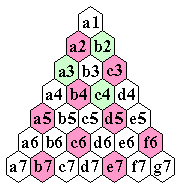| 28 Hole Triangular Board |
[Preliminary
results] |
|
| Single Vacancy
to Single Survivor Problems |
|
| # |
Vacate |
Finish
at |
Length of Shortest Solution |
Number of Solutions |
Longest Sweep |
Longest Finishing Sweep |
Shortest Longest Sweep |
Number of Final Moves |
#(Longest, Second longest,
Final) [Comment] |
| 1 |
(0,-1) |
a2 |
(1,-1) |
b2 |
12 |
25 |
5 |
5 |
5 |
1 |
8(5,5,5), 17(5,4,5) |
| 2 |
(1,-6) |
b7 |
(1,-1) |
b2 |
12 |
6 |
6 |
5 |
5 |
2 |
2(6,5,5), 4(5,4,5) |
| 3 |
(5,-5) |
f6 |
(1,-1) |
b2 |
13 |
938 |
9 |
7 |
3 |
37 |
3(9,2,2), 1(8,3,3), 2(8,3,2), 8(8,2,2), 9(7,4,7),
3(7,4,4), 3(7,4,2), etc. |
| 4 |
(0,-4) |
a5 |
(1,-1) |
b2 |
12 |
|
|
|
|
|
|
| 5 |
(4,-6) |
e7 |
(1,-1) |
b2 |
12 |
|
|
|
|
|
|
| 6 |
(2,-2) |
c3 |
(1,-1) |
b2 |
12 |
|
|
|
|
|
|
| 7 |
(1,-3) |
b4 |
(1,-1) |
b2 |
12 |
|
|
|
|
|
|
| 8 |
(3,-4) |
d5 |
(1,-1) |
b2 |
12 |
|
|
|
|
|
|
| 9 |
(2,-5) |
c6 |
(1,-1) |
b2 |
13 |
|
|
|
|
|
|
| 10 |
(0,-1) |
a2 |
(0,-2) |
a3 |
12 |
|
|
|
|
|
|
| 11 |
(1,-6) |
b7 |
(0,-2) |
a3 |
12 |
|
|
|
|
|
|
| 12 |
(5,-5) |
f6 |
(0,-2) |
a3 |
12 |
|
|
|
|
|
|
| 13 |
(0,-4) |
a5 |
(0,-2) |
a3 |
12 |
274 |
11 |
11 |
4 |
57 |
1(11,2,11), 2(10,3,10), 8(9,3,9), 13(8,4,8), 11(8,3,8),
2(7,6,7), 7(7,5,7), etc. |
| 14 |
(4,-6) |
e7 |
(0,-2) |
a3 |
12 |
311 |
9 |
9 |
4 |
47 |
2(9,4,9), 1(9,3,9), 1(9,2,9), 2(8,4,8), 1(7,5,7),
17(7,4,7), 4(7,4,1), |
| 15 |
(2,-2) |
c3 |
(0,-2) |
a3 |
12 |
419 |
10 |
10 |
4 |
54 |
1(10,3,10), 4(9,3,9), 7(8,4,8), 2(8,3,1), 2(7,6,6),
1(7,5,7), 1(7,5,2), etc. |
| 16 |
(1,-3) |
b4 |
(0,-2) |
a3 |
12 |
|
|
|
|
|
|
| 17 |
(3,-4) |
d5 |
(0,-2) |
a3 |
12 |
|
|
|
|
|
|
| 18 |
(2,-5) |
c6 |
(0,-2) |
a3 |
12 |
|
|
|
|
|
|
| 19 |
(0,-1) |
a2 |
(2,-3) |
c4 |
13 |
|
|
|
|
|
|
| 20 |
(1,-6) |
b7 |
(2,-3) |
c4 |
13 |
|
|
|
|
|
|
| 21 |
(5,-5) |
f6 |
(2,-3) |
c4 |
13 |
|
|
|
|
|
|
| 22 |
(0,-4) |
a5 |
(2,-3) |
c4 |
12 |
|
|
|
|
|
|
| 23 |
(4,-6) |
e7 |
(2,-3) |
c4 |
12 |
|
|
|
|
|
|
| 24 |
(2,-2) |
c3 |
(2,-3) |
c4 |
12 |
13 |
7 |
5 |
4 |
3 |
1(7,6,3), 2(6,5,5), 2(5,4,4), 8(4,4,4) |
| 25 |
(1,-3) |
b4 |
(2,-3) |
c4 |
13 |
1000 |
7 |
7 |
3 |
26 |
4(7,3,7), 8(7,3,3), 2(7,3,2), 1(6,6,6), 8(6,5,6),
2(6,5,4), 24(6,4,6), etc. |
| 26 |
(3,-4) |
d5 |
(2,-3) |
c4 |
13 |
|
|
|
|
|
|
| 27 |
(2,-5) |
c6 |
(2,-3) |
c4 |
13 |
|
|
|
|
|
|
| |
|
|
|
|
Total: |
2986 |
|
|
|
|
|
| Column
Definitions: |
|
|
|
|
|
|
|
| Length of
Shortest Solution |
This is the length of the shortest solution to
this problem, minimizing total moves |
| Number of
Solutions |
|
This is the number of unique solution
sequences, irregardless of move order and symmetry |
| Longest Sweep |
|
|
This is the longest sweep possible in any
minimal length solution [link to solution] |
| Longest
Finishing Sweep |
This is the longest sweep in the final move of
any minimal length solution [link] |
| Shortest
Longest Sweep |
There is no minimal length solution where all
sweeps are shorter than this number [link] |
| Number of Final
Moves |
This is the number of different finishing moves
(up to symmetry) |
| #(Longest, Second Longest, |
Eg. 12(8,7,2) indicates there are 12 solutions
with different move sequences, where |
|
|
|
|
|
, Final) |
the longest sweep is 8, the second longest
sweep is 7, and the final sweep is 2 |
| (S) Problem is
symmetric, multiple solutions counted as one |
|
|
|
| Solution
differences can be very subtle. |
|
|
|
|
|
| Download a zip
file with all XXXX solutions |
|
|
|
|
|
|
|
|
|
|
|
|
|
|
|
|
|
|
|
|
|
|
|
|
|
|
|
|
|

